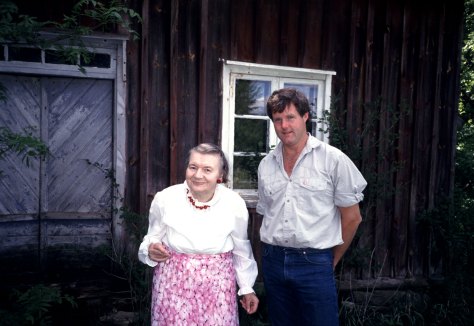
I had many unforgettable moments with Elsa during the five years we were filming the story of her life. One Sunday, in the summer of 2003, we drove to Halmstad on the southwest coast of Sweden to visit one of the institutions where she was confined for two years in the 1930’s. Still in use, it is now a home for developmentally challenged men who, during the day, had jobs in the area. I had already contacted the home and they were waiting for us. Elsa was greeted like a celebrity. They had prepared a meal and coffee and Elsa enjoyed herself immensely as she told them about life in the institution during the 30’s. The personnel were fascinated by her memories and her stories.
We left the institution in Halmstad in the afternoon and began the drive home to Vårgårda, but Elsa wasn’t quite ready to end the excursion. When we had come about half way and were nearing the city of Borås, Elsa asked, “Can’t we stop for dinner?” When Elsa said “dinner” she usually meant coffee and a sweet roll. It was five minutes to six and I knew that most of the cafés closed at six. It was going to be tight. I stopped outside a café and rushed in to see if they would stay open a little longer for Elsa. The girl behind the counter wasn’t thrilled but said if we hurried, she would serve us.
I ran back to the car to get Elsa and escort her into the café as quickly as possible. Elsa walked severely stooped with her face to the ground and commented about everything she saw. If we passed a flower she had to stop and talk to it for awhile, so we didn’t move very fast. I think we walked through the doors right at six o’clock. We placed our order with the girl at the counter and then sat down at a nearby table.
There were about 15 other people in the café who were finishing up their coffees. The girl who had taken our order soon arrived at our table carrying our coffee and rolls on a tray. As she was laying out the items on the table, Elsa began to tell her life story. The waitress looked slightly uncomfortable and I was terribly embarrassed. I thought to myself, “I hope they don’t think that she is my mother. Please, Elsa, stop!”
But Elsa didn’t stop; she continued to tell her story and before long the atmosphere in the café seemed to change. It was 6:30 and Elsa was still telling her story when I looked up. The waitress was still standing there and all the other people in the café were now standing around our table listening intently.
When I realized how moved those people were by Elsa’s amazing but tragic story, I was ashamed of my earlier embarrassment over Elsa’s eagerness to talk to strangers in a café. Instead, I sat up straight, proud to be Elsa’s friend, and listened along with the others. At 7 o’clock Elsa paused to take a breath and I grabbed the chance to say, “Maybe we should be getting home now, Elsa?”
Elsa agreed and we all left the café in silence. I am sure that no one listening that afternoon in Borås will ever forget my friend, Elsa.
Elsa and I visited all of the institutions where she had been incarcerated for over 30 years. I also went with her to birthday parties, shopping and to cafés, filming everything she did. Once, it nearly ended in a catastrophe.
Elsa had purchased a small summer cottage where she occasionally stayed for a couple of days. It was located deep in the forest and she didn’t have a telephone or other conveniences. One day she asked me if I could drive her out to her cottage and then come and pick her up the next day. Sure, no problem! We drove out to the cottage and I had a cup of coffee with her before I went home. Elsa was going to spend the night. But, to my eternal shame, I forgot about Elsa! A couple of days later I was at a party in the evening when someone asked, ”How’s the film about Elsa going?” Devastated, I realized that Elsa was still out there, alone in the forest. I left the party, jumped into my car and raced out to the cottage.
It was less than a half hour’s drive, but during that time strange thoughts flooded my mind. What if Elsa was lying dead in the cottage? What if she tried to walk home and had collapsed in a ditch by the side of the road? Those were anxious minutes before I reached the cottage.
I rushed inside without knocking and there was Elsa sitting by the kitchen table. She looked up and smiled. “It’s a good thing that you came now,” she said, “that was my last piece of sweet roll.” She swallowed the last sip of coffee and finished her roll. We climbed into the car and drove home. Elsa never mentioned that I forgot her out there at the cottage. She was always happy and grateful every time we were out on an adventure.
More next week about working with Elsa. The movie “My Dear Elsa” tells her story from degradation to triumph. See it on DVD and Vimeo .



